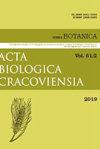从橡树(Quercus robur L.)到山毛榉(Fagus sylvatica L.)优势林分生态演替的遗传学研究
IF 0.5
4区 生物学
Q4 PLANT SCIENCES
引用次数: 9
摘要
遗传多样性通常被认为是种群长期持续性及其适应可变环境条件的潜力的主要决定因素。种群跨代保持遗传多样性的能力似乎是其可持续性的主要先决条件,这对关键森林树种尤为重要。然而,在涉及物种组成变化的生态演替自然过程中,人口结构变化的遗传后果知之甚少。利用微卫星,我们研究了山毛榉(Fagus sylvatica L.)和橡树(Quercus robur L。总的来说,这两个物种的成年世代都表现出高水平的遗传多样性(山毛榉为0.657;橡树为0.821),但这取决于选定的遗传标记集。然而,几代人之间遗传多样性指数的差异、显著的近亲繁殖水平(高达0.029)和有效种群规模的低估计值(48-80)等一些症状证实了橡树种群的下降状态。另一方面,遗传多样性指数在各代之间的均匀分布、低水平的近亲繁殖(0.004)、成年和后代之间的低遗传分化,以及最重要的是,对有效种群规模的大量估计(119–716),都支持山毛榉成为所研究林分中连续且成功的树种。本文章由计算机程序翻译,如有差异,请以英文原文为准。
Genetic Insights into Ecological Succession from Oak- (Quercus robur L.) to Beech- (Fagus sylvatica L.) Dominated Forest Stands
Genetic diversity is often considered a major determinant of long term population persistence and its potential to adapt to variable environmental conditions. The ability of populations to maintain their genetic diversity across generations seems to be a major prerequisite for their sustainability, which is particularly important for keystone forest tree species. However, little is known about genetic consequences of demographic alterations occurring during natural processes of ecological succession involving changes in the species composition. Using microsatellites, we investigated genetic diversity of adult and offspring generations in beech (Fagus sylvatica L.) and oak (Quercus robur L.) populations coexisting in a naturally established old-growth forest stand, showing some symptoms of ongoing ecological succession from oakto beechdominated forest. In general, adult generations of both species exhibited high levels of genetic diversity (0.657 for beech; 0.821 for oak), which, however, depended on the sets of selected genetic markers. Nevertheless, several symptoms such as differences in genetic diversity indices between generations, significant levels of inbreeding (up to 0.029) and low estimates of effective population size (48–80) confirmed the declining status of the oak population. On the other hand, the uniform distribution of genetic diversity indices across generations, low levels of inbreeding (0.004), low genetic differentiation among adults and offspring and, most importantly, large estimates of effective population size (119–716), all supported beech as a successive and successful tree species in the studied forest stand.
求助全文
通过发布文献求助,成功后即可免费获取论文全文。
去求助
来源期刊
CiteScore
3.00
自引率
0.00%
发文量
0
审稿时长
>12 weeks
期刊介绍:
ACTA BIOLOGICA CRACOVIENSIA Series Botanica is an English-language journal founded in 1958, devoted to plant anatomy and morphology, cytology, genetics, embryology, tissue culture, physiology, biochemistry, biosystematics, molecular phylogenetics and phylogeography, as well as phytochemistry. It is published twice a year.

 求助内容:
求助内容: 应助结果提醒方式:
应助结果提醒方式:


